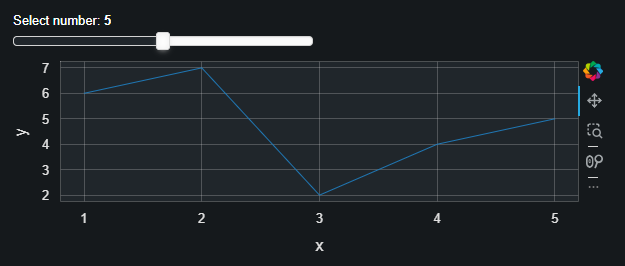What are you trying to do?
Create a library that allows me to plot up to 400pts/sec in realtime. This is working but I am hoping to prettify the UI but cant seem to find an option to set the background colour for the parent page.
What have you tried that did NOT work as expected?
I can find the options to change the theme of widgets but not the parent(Bokeh Page) container
If this is a question about Bokeh code, YES
class BokehPage:
def __init__(self, defaults: LayoutDefaults, sensor_is_reading: Event) -> None:
"""Initialse page/canvas
Args:
defaults (LayoutDefaults): default setup values
"""
self.doc = curdoc()
curdoc().theme = "dark_minimal"
self.defaults = defaults
self.window_width = self.defaults.window_slider_value
self.start_stop_checkbox = None
self.window_width_slider = None
self.sensor_speed_slider = None
self.all_plots = None
self.plots = None
self.sensor_is_reading = sensor_is_reading
self.header = Div(
text=f"<h1 style='color:{defaults.page_title_colour}'>{defaults.page_title}</h1>",
width=defaults.page_title_width,
height=defaults.page_title_height,
background="black",
)
def add_plots(self, plots: List["BokehPlot"]):
"""Add plots to window
Args:
plots (List[BokehPlot]): list of bokeh plots showing sensor data
"""
self.plots = plots
grid_plot = []
for p in plots:
grid_plot.append(p.plt)
n = self.defaults.n_columns
grid_plot = [grid_plot[i : i + n] for i in range(0, len(grid_plot), n)]
self.all_plots = gridplot(
grid_plot,
)
self.all_plots.spacing = 10
self.layout()
def layout(self):
"""Add plots and sliders to layout"""
self.doc.title = self.defaults.page_title
self.start_stop_checkbox = CheckboxGroup(labels=["Enable Plotting"], active=[0])
self.start_stop_checkbox.on_change("active", self.start_stop_handler)
self.window_width_slider = Slider(
start=self.defaults.window_slider_start,
end=self.defaults.window_slider_end,
value=self.defaults.window_slider_value,
step=self.defaults.window_slider_step,
title="window_width",
)
self.window_width_slider.on_change("value", self.window_width_handler)
# adjust delay from sensor data updates. Can be removed for real data
self.sensor_speed = Slider(
start=self.defaults.sensor_speed_slider_start,
end=self.defaults.sensor_speed_slider_end,
value=self.defaults.sensor_speed_slider_value,
step=self.defaults.sensor_speed_slider_step,
title="Sensor Update delay",
)
self.sensor_speed.on_change("value", self.sensor_speed_handler)
self.hertz_div = Div(
text=f"<b>Each plot is updating at {1/self.defaults.sensor_speed_slider_value:.1f}Hz</b>"
)
a = 1
itms = [
self.header,
self.start_stop_checkbox,
self.window_width_slider,
self.sensor_speed,
self.hertz_div,
self.all_plots,
]
for itm in itms:
itm.sizing_mode = "stretch_width"
layout = column(*itms)
layout.sizing_mode = "stretch_width"
self.doc.add_root(layout)
def start_stop_handler(self, attr: str, old: int, new: int):
"""Pause plot updates so you can
Args:
attr (str): only used as a placeholder
old (int): only used as a placeholder
new (int): current checkbox value: 0 off, 1 on
"""
if new:
self.sensor_is_reading.set()
else:
self.sensor_is_reading.clear()
def window_width_handler(self, attr, old, new):
"""Pause plot updates so you can
Args:
attr (str): only used as a placeholder
old (int): only used as a placeholder
new (int): sets with of rolling window
"""
self.window_width = new
def sensor_speed_handler(self, attr, old, new):
"""Pause plot updates so you can
Args:
attr (str): only used as a placeholder
old (int): only used as a placeholder
new (int): sets delay between sensor updates
"""
self.hertz_div.text = f"<b>Each plot is updating at {1/new:.1f}Hz</b>"
self.defaults.delay_queue.append(new)
class BokehPlot:
def __init__(self, parent: BokehPage, sensor_details: SensorDetails) -> None:
"""Initialise a plot
Args:
parent (BokehPage): parent that will contain the plot
signal (SensorConsumer): sensor signal producer
"""
self.parent = parent
self.doc = parent.doc
self.colours = cycle(palette)
self.defaults = PlotDefaults(sensor_details)
self.plot_options = dict(
width=self.defaults.plot_width,
height=self.defaults.plot_height,
tools=[
HoverTool(tooltips=self.defaults.tooltips),
self.defaults.plot_tools,
],
)
self.source, self.plt = self.definePlot()
def definePlot(self):
"""Automaticaaly define the plot based on the legend data supplied in Main
Returns:
(source, plt): (source data for sensor, plot data based on sensor data)
"""
plt = figure(**self.plot_options, title=self.defaults.plot_title)
plt.sizing_mode = "scale_width"
plt.xaxis.axis_label = self.defaults.xaxis_label
plt.yaxis.axis_label = self.defaults.yaxis_label
# if multiple y values (eg y, y1,y2...yn) in plot create a multiline plot
data = {_y: [0] for _y in self.defaults.ys_legend_text.keys()}
data["x"] = [0]
source = ColumnDataSource(data=data)
items = []
for y, legend_text in self.defaults.ys_legend_text.items():
colour = next(self.colours)
r1 = plt.line(x="x", y=y, source=source, line_width=2, color=colour)
r1a = plt.circle(
x="x", y=y, source=source, fill_color="white", size=5, color=colour
)
items.append((legend_text, [r1, r1a]))
legend = Legend(items=items)
plt.add_layout(legend, "right")
plt.legend.click_policy = "hide"
return source, plt
@gen.coroutine
def update(self, new_data: dict):
"""update source data from sensor data
Args:
new_data (dict): newest data
"""
if self.parent.sensor_is_reading.is_set():
self.source.stream(new_data, rollover=self.parent.window_width)
full code at
fast_sensor_stream/bokeh_stream/bokeh_plot.py at main · hidara2000/fast_sensor_stream (github.com)
I would have thought that the line
curdoc().theme = "dark_minimal"
could have addressed this
Any help would be appreciated, cheers.


